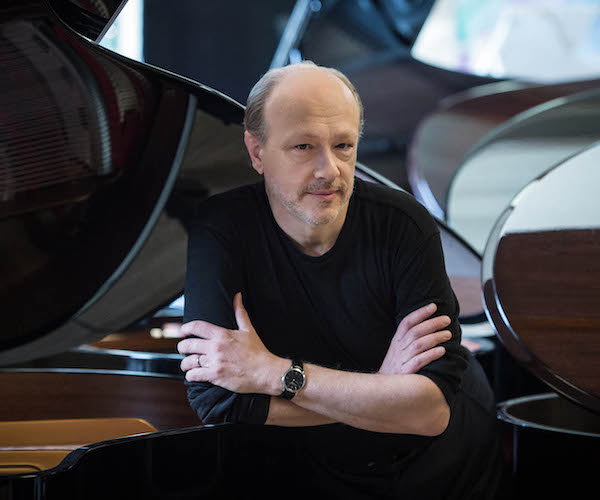Concert Review: Marc-André Hamelin plays Ives, Hamelin, Schumann, and Ravel
By Jonathan Blumhofer
Pianist Marc-André Hamelin demonstrated a total command and control of his materials.

Canadian pianist Marc-André Hamelin — an engaging reminder that the pianist-composer/composer-pianist tradition remains alive and well. Photo: courtesy of the artist
On the merits of his recital at Mechanics Hall Thursday night, it’s safe to say that Marc-André Hamelin isn’t one to take the easy route. The Canadian pianist’s program for his Music Worcester appearance offered not one, but two musical monuments — Charles Ives’s Concord Sonata and Maurice Ravel’s Gaspard de la nuit — in addition to a substantial rarity by Robert Schumann and the pianist’s own Mazurka.
At one time, Ives’s 45-minute-long behemoth might, by itself, have been plenty. Completed in 1915, the work is a meditation on figures associated with New England’s transcendentalist movement. Its language is dense and dissonant, the structure sometimes discursive. This being Ives, there are musical quotations galore, from the opening motto of Beethoven’s Fifth Symphony to hymn tunes, marches, and popular airs. In lesser hands, it might unwind as little more than a jumble.
Yet for all the complexity of its textures, rhythms, and harmonies, what transpired Thursday was beguilingly songful, shapely, and warm. Hamelin’s voicings were always clear and focused. He consistently teased out the melodic line in the opening “Emerson” movement, giving direction to its peculiar turns of phrase while imbuing the statements of the Beethoven motive with granitic weight.
In the process of illuminating Concord’s architecture, the pianist drew from his Steinway a huge array of dynamics and colors. The hazy textures of “Hawthorne,” for instance, moved with becoming naturalness to the jaunty syncopations of a nightmarish ragtime, then a swaggering march, and, later, devotional snatches of a chorale-like tune accompanied by dreamy, bluesy tone clusters.
Though something of a respite, “The Alcotts” unfolded with a sense of steely rightness. Likewise, the concluding “Thoreau”‘s rhapsodic, improvisational aspect came out cleanly; its closing bars were hypnotic.
For all the sobriety latent in this music, Hamelin didn’t shy away from its lighter turns, particularly during “Hawthorne” and in the charming, simple middle section of “The Alcotts.” The end result, as the evening’s attentive audience seemed to intuit, was a fundamentally humane portrait of Ives and his subject matter.
Written in 1908, Ravel’s Gaspard de la nuit is only just about half as long as Concord. Even so, its three movements (each of which references a poem by Aloysius Bertrand) presents demands that are equally fearsome.
On Thursday, though, Hamelin demonstrated a total command and control of his materials. He dispatched “Ondine” with outstanding balances and luminous textures. “Le Gibet” strode with a focused rhythmic intensity that neatly matched the pianist’s close attention to dynamic nuances. Meanwhile, “Scarbo,” for all its spastic unpredictability (and countless notes) emerged as something of an inversion of Ives’s “Thoreau”: its blocks of ideas at once acerbic, characterful, colorful, and haunting.
Schumann’s Waldszenen offered some of those latter qualities, too. His last major work for solo piano, the score has languished, in part because of its association with the composer’s declining mental health at the time of its composition.
Nevertheless, Hamelin’s reading at Mechanics painted the shadows found in its nine short movements with care, especially the enchanting dissonances of “Vogel als Prophet.” These spoke with piercing clarity, even though the pianist’s dynamic range rarely rose above a whisper.
At the same time, Hamelin embraced the music’s melodic richness. “Einsame Blumen” danced with inward energy. “Herberge” was flexibly phrased and impeccably voiced. The “Jagdlied” sang with a lusty abandon that smartly countered the “Abschied’s” limpid serenity.
A similar introspection marked his own Mazurka, which was receiving its local premiere. Ruminative, active — both hands were kept very busy over its four- or five-minute duration — evincing a sort of Bill Evans-meets-Chopin (or is it Ravel?) vibe, Hamelin’s effort was an engaging reminder that the pianist-composer/composer-pianist tradition (all of the night’s authors were such) remains alive and well.
For an encore, Hamelin channeled another one of those, C.P E. Bach, whose quizzical Rondo in C minor received a fittingly droll and characteristic outing.
Jonathan Blumhofer is a composer and violist who has been active in the greater Boston area since 2004. His music has received numerous awards and been performed by various ensembles, including the American Composers Orchestra, Kiev Philharmonic, Camerata Chicago, Xanthos Ensemble, and Juventas New Music Group. Since receiving his doctorate from Boston University in 2010, Jon has taught at Clark University, Worcester Polytechnic Institute, and online for the University of Phoenix, in addition to writing music criticism for the Worcester Telegram & Gazette.


Lovely review, Jonathan! I adored the concert — well worth the trip!
This review, together with the one in The Intelligencer, has given me a terrific idea of the performance. I could not go, so these were good to read. Hamelin to me, is in the class of Lang, Ax, Levit, Wang, and Kissin. I listen to his music on Spotify all the time. He lives in the Boston area and I wish he would perform here more.